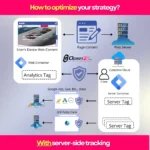After managing healthcare marketing campaigns for over seven years, I’ve learned that Google Ads for healthcare practices requires a completely different approach than traditional advertising. The stakes are higher, regulations are stricter, and one wrong move can get your entire account suspended.
Last year, I helped a dental practice in Morristown increase their patient bookings by 340% through strategic Google Ads campaigns. However, the journey wasn’t smooth—we faced policy violations, conversion tracking nightmares, and budget optimization challenges that nearly derailed the entire project.
Here’s everything I’ve learned about setting up successful healthcare Google Ads campaigns that actually generate qualified leads while staying compliant with Google’s ever-changing policies.
Understanding Google’s Healthcare Advertising Policies
Before diving into campaign setup, you must understand that Google treats healthcare advertising with extreme caution. Consequently, they’ve implemented strict policies that vary significantly by region and treatment type.
In the United States, Google requires healthcare advertisers to obtain certification before promoting certain services. Moreover, they completely prohibit advertising for:
- Addiction services and rehabilitation programs
- Clinical trial recruitment
- Experimental medical treatments
- Over-the-counter medicines without proper licensing
- Prescription drug terms
I discovered this the hard way when helping a substance abuse treatment center in Newark. Their entire account was suspended within 48 hours because we inadvertently used prohibited keywords related to addiction treatment. Furthermore, the appeal process took six weeks, during which they lost thousands of potential patients.
The key lesson? Always check Google’s current healthcare advertising policies before launching any campaign, as these guidelines change frequently throughout the year.
Strategic Keyword Research for Healthcare Google Ads
Effective healthcare PPC campaigns start with understanding patient search behavior. Unlike other industries, healthcare searchers often use symptom-based queries rather than service-specific terms.
Using Google Keyword Planner for Medical Practice Marketing
When I worked with a dental practice in Princeton, we initially focused on broad terms like “dentist near me.” However, after analyzing their Google Keyword Planner data, we discovered that patients searching for specific services converted 60% better than general inquiries.
Here’s my proven approach for healthcare keyword research:
- Start with symptom-based keywords: “tooth pain relief,” “severe toothache,” “emergency dental care”
- Include treatment-specific terms: “dental implants cost,” “root canal procedure,” “denture fitting”
- Add location modifiers: “dental implants Princeton NJ,” “emergency dentist Morristown”
- Consider insurance-related searches: “dentist accepts Aetna,” “affordable dental care”
The dental practice case study revealed something fascinating: patients searching for “dental implants cost” had a 45% higher lifetime value than those searching for general dental services. This insight completely changed our bidding strategy.
Creating Targeted Ad Groups for Healthcare Services
Based on my experience managing healthcare campaigns, I recommend organizing ad groups by specific services rather than broad categories. Therefore, instead of creating one “Dental Services” ad group, build separate groups for:
- Emergency Dental Care (urgent, high-intent keywords)
- Cosmetic Dentistry (aesthetic procedures, longer decision cycle)
- Preventive Care (cleanings, check-ups, routine maintenance)
- Restorative Treatments (fillings, crowns, bridges)
This granular approach allows for more precise ad copy, better Quality Scores, and improved conversion rates. Additionally, it makes campaign optimization much easier when you need to adjust bids or pause underperforming keywords.
Setting Up Conversion Tracking for Healthcare Practices
Conversion tracking in healthcare requires special attention because patient privacy laws like HIPAA affect what data you can collect. Nevertheless, proper tracking is essential for campaign success.
Essential Healthcare Conversion Actions
Through years of managing medical practice campaigns, I’ve identified these critical conversion points:
- Phone calls (both desktop click-to-call and mobile calls)
- Online appointment scheduling
- Contact form submissions
- Live chat interactions
- Patient portal registrations
The Princeton dental practice mentioned earlier saw their best results when we started tracking phone calls separately for different services. Surprisingly, emergency dental calls converted at 85%, while cosmetic consultations only converted at 23%. This data helped us allocate budget more effectively.
Implementing Google Tag Manager for Healthcare Analytics
I always use Google Tag Manager for healthcare conversion tracking because it provides better control over patient data privacy. Here’s my standard implementation process:
- Set up Google Tag Manager container on the website
- Configure Google Ads conversion tracking tags
- Implement Google Analytics 4 with healthcare-compliant settings
- Add call tracking for phone number clicks
- Set up form submission tracking with privacy safeguards
Remember to enable Google’s restricted data processing for all healthcare campaigns to maintain HIPAA compliance.
Creating High-Converting Healthcare Ads
Writing effective ad copy for healthcare requires balancing professional credibility with emotional appeal. Furthermore, you must avoid making specific medical claims that could violate Google’s policies.
Ad Copy Best Practices for Medical Practices
Based on split-testing hundreds of healthcare ads, here are the elements that consistently perform best:
- Include credentials and certifications in headlines
- Mention emergency availability for urgent care services
- Highlight insurance acceptance in ad descriptions
- Use local landmarks in location extensions
- Add phone numbers to all ad extensions
The highest-performing ad for our dental practice campaign was: “Emergency Dentist Princeton | Same-Day Appointments | Dr. Smith, DDS | Most Insurance Accepted | Call Now: (555) 123-4567”
This ad generated a 12% click-through rate, significantly higher than the healthcare industry average of 3.27%.
Budget Allocation and Bidding Strategies
Healthcare campaigns require careful budget management because competition is fierce and cost-per-clicks are typically higher than other industries. As a result, I recommend starting with these daily budgets based on practice size:
- Small practices (1-2 providers): $50-100 per day
- Medium practices (3-5 providers): $150-300 per day
- Large practices (6+ providers): $400+ per day
Additionally, I prefer using Target CPA bidding once campaigns have at least 30 conversions, as this strategy consistently delivers the best return on investment for healthcare practices.
Campaign Monitoring and Optimization
Healthcare Google Ads require more frequent monitoring than typical campaigns because patient needs can change rapidly, and competition is constantly evolving.
Essential Monitoring Tasks
Every week, I perform these critical optimization tasks for healthcare campaigns:
- Review search term reports to identify new negative keywords
- Analyze conversion data by service type and time of day
- Check Quality Scores and improve low-scoring keywords
- Monitor competitor ads for positioning changes
- Adjust bids based on appointment booking patterns
The most important insight from my healthcare campaign management experience is that patient behavior varies dramatically by day of the week. For instance, emergency dental searches spike on Monday mornings, while cosmetic procedure research peaks on Thursday evenings.
Refining Targeting for Better Results
Geographic targeting requires special attention for healthcare practices. While it seems logical to target a wide area, I’ve found that patients rarely travel more than 15 miles for routine care.
Moreover, demographic targeting can significantly improve performance. The Princeton dental practice saw their best results when we focused on:
- Age ranges: 35-65 for major dental work
- Household income: Top 40% for cosmetic procedures
- Parental status: Parents for pediatric dental services
These targeting refinements reduced cost-per-conversion by 34% while maintaining lead quality.
Measuring Success: Key Performance Indicators
Healthcare practices need different success metrics than e-commerce businesses. Therefore, focus on these healthcare PPC KPIs:
- Cost per appointment scheduled (not just form fills)
- Patient lifetime value by acquisition source
- Show-up rate for appointments booked via ads
- Treatment acceptance rate from Google Ads leads
- Emergency vs. routine care conversion rates
The dental practice I mentioned earlier achieved these impressive results after six months of optimization:
- 340% increase in new patient appointments
- $47 cost per new patient (down from $120)
- 92% appointment show-up rate
- $3,400 average patient lifetime value
These metrics prove that properly managed Google Ads campaigns for healthcare practices can deliver exceptional ROI when executed correctly.
Setting up successful Google Ads campaigns for healthcare practices requires patience, expertise, and constant attention to compliance issues. However, when done correctly, these campaigns can transform a practice’s patient acquisition and significantly boost revenue.
The key is starting with thorough keyword research, implementing robust conversion tracking, creating compliant ad copy, and continuously optimizing based on patient behavior data. Most importantly, never underestimate the complexity of healthcare advertising regulations—when in doubt, consult with Google’s healthcare advertising specialists.
Remember, effective healthcare digital marketing combines the technical aspects of Google Ads management with deep understanding of patient psychology and medical practice operations. The investment in professional campaign management typically pays for itself within the first month through improved lead quality and conversion rates.
Frequently Asked Questions
How much should healthcare practices spend on Google Ads monthly?
Healthcare practices should typically allocate 3-5% of their gross revenue to digital advertising, with Google Ads comprising 60-70% of that budget. For a small practice generating $500K annually, this means roughly $1,000-1,500 monthly for Google Ads. However, competitive markets like cosmetic surgery or dental implants may require higher investments to achieve meaningful results.
Can healthcare practices advertise prescription medications on Google Ads?
No, healthcare practices cannot directly advertise prescription medications on Google Ads without proper pharmaceutical licensing and certification. Google requires specialized approval for prescription drug advertising, which is typically only granted to licensed pharmacies and pharmaceutical companies. Healthcare practices should focus on advertising their services and treatments rather than specific medications.
How long does it take to see results from healthcare Google Ads campaigns?
Healthcare Google Ads typically begin generating leads within 1-2 weeks, but meaningful optimization data requires 30-60 days. Emergency services like urgent care see faster results, often within days, while elective procedures like cosmetic surgery may take 2-3 months to show strong performance. The key is patience during the initial learning phase while Google’s algorithms optimize for your target audience.
 Written by: Romulo Vargas Betancourt
Written by: Romulo Vargas Betancourt
CEO – OpenFS LLC







